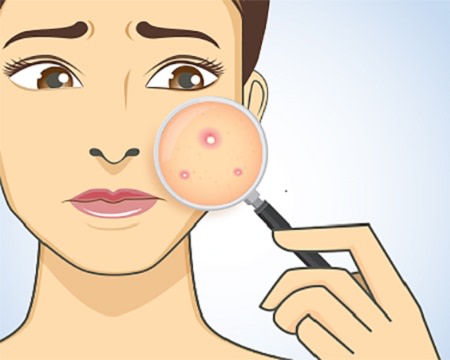Overview of ACNE

As a result of clogged hair follicles beneath the skin, acne is a frequent skin disorder. Dead skin cells and sebum, oil that helps prevent skin from drying out, clog pores, causing lesions to appear, often known as pimples or zits. The face is where the outbreaks typically occur, although can also show up on the shoulders, chest, and back.
Acne is an inflammatory condition that affects the skin's sebaceous (oil) glands and hair follicles, which are home to fine hairs. Sebum produced by the sebaceous glands in healthy skin is released onto the skin's surface through the pore, a follicular opening. The follicle is lined with skin cells called keratinocytes. The keratinocytes typically climb to the skin's surface during skin cell shedding. Hair, sebum, and keratinocytes clump together in the pore of an acne patient. As a result, the keratinocytes are kept from shedding and sebum is kept from penetrating the skin's surface. Inflammation, including swelling, redness, heat, and pain, is brought on by bacteria that ordinarily reside on the skin and can proliferate in clogged follicles when oil and cells are present. Lesions or pimples are produced when the wall of the clogged follicle collapses, spilling germs, skin cells, and oil onto the neighboring skin.
Who gets Acne?
Acne affects people of all races and ages, but it is particularly common in teens and young adults. Acne is more common in male teens when it first takes place. Acne can last into adulthood, and when it occurs, women are more likely to develop it.
Types of Acne
Acne causes several types of pimples.
1. Whiteheads: Plugged hair follicles that stay beneath the skin and produce a white bump.
2. Blackheads: Plugged follicles that reach the surface of the skin and open up. They look black on the skin surface because the air discolors the sebum, not because they are dirty.
3. Papules: Inflamed lesions that usually appear as small, pink bumps on the skin and can be tender to the touch.
4. Pimples: Pimples topped by white or yellow pus-filled lesions that may be red at the base.
5. Nodules: Large, painful solid lesions that are lodged deep within the skin.
6. Severe nodular acne (sometimes called cystic acne): Deep, painful, pus-filled lesions.
Causes of Acne
Doctors and researchers think that any one or more of the following factors may contribute to acne development:
1. A high or excessive oil production rate in the pore.
2. The pore becomes clogged with dead skin cells.
3. Bacterial growth in the pore.
The following factors may increase your risk for developing acne:
Hormones: Acne may result from an increase in androgens, or male sex hormones. These typically rise during puberty in both boys and girls, causing the sebaceous glands to grow and produce more sebum. Acne can also be brought on by pregnancy-related hormonal changes. Family background: If your parents had acne, you might be more likely to develop acne, according to researchers.
Age: Acne can affect anyone at any age, although teens are more likely to have it.
Medications: Acne can be brought on by some medicines, including hormone- containing, corticosteroid-containing, and lithium-containing ones.
The following do not cause acne, but may make it worse.
1. Diet: According to certain studies, eating particular foods could worsen
acne. Acne's relationship to nutrition is still being researched by scientists.
2. Stress.
3. Pressure from backpacks, fitted clothing, or sports helmets.
4. Irritations caused by the environment, such as pollution and high humidity.
5. Rubbing or picking at blemishes.
6. Rubbing your skin excessively hard.
Acne Skin Care Tips
Gently wash your skin: After strenuous exercise and in the morning, evening, and both, uses a gentle cleaner. Avoid using astringents, harsh scrub pads, or powerful soaps. Use warm water to rinse your skin.
Regularly shampoo your hair: You might wish to shampoo your hair every day if it is oily.
Refrain from touching and rubbing skin lesions: Scars or black blotches may appear after picking or squeezing blemishes.
Shave carefully: Before using shaving cream, make sure the blade is sharp and soften the hair with soap and water. To lessen the chance of nicking blemishes, only shave softly and when absolutely required.
Use sunscreen, and avoid sunburn and suntan: Many acne medications can increase the likelihood of developing to sunburn.
Choose cosmetics carefully: All cosmetics and hair care items must to be free of oils. Select items that are noncomedogenic, which implies that they don't clog pores. However, even these products have the potential to worsen acne in certain people.

Leave a Reply